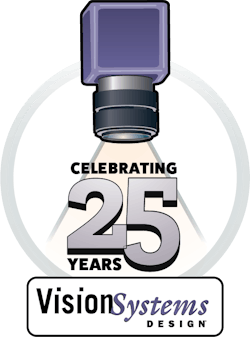VSD 25th Anniversary Q&A series: Matrox Imaging discusses the past, present, and future
Vision Systems Design celebrates its 25th anniversary in 2021. What are some of the most interesting and notable machine vision advancements you’ve seen since you entered the space?
It seems a bit odd to say, and perhaps I’m aging myself here, but the most significant advancement is really the invention and proliferation of the PC! The PC has become ubiquitous throughout the machine vision world. Solving machine-vision problems prior to the PC required specialized—and likely complex and expensive—hardware. The advent of the PC made those solutions far more attainable and affordable.
The PC also built on a technology people understood and were familiar with, and in that way the PC became the platform of choice. PCs evolved over the years to meet the ever-growing challenges of increased and improved performance, offering the flexibility to meet the demands of machine vision and factory automation applications. Certainly, machine vision software has evolved exponentially over this time, and its sophistication has grown leaps and bounds, but the software runs on the PC, and it’s really the notable existence of the PC that enables this to happen.
Do you have any notable Vision Systems Design-related stories to share from over the years?
Ask Judy Leger! VSD has always been accommodating and professional towards Matrox Imaging, and we see them as a strategic partner. Judy has been our point of contact throughout VSD’s existence; she has great perspective and memories of our journey together.
Thoughts from Judy:
Matrox Imaging was instrumental in the birth of Vision Systems Design. Back in the mid ‘90s when the sales staff of Laser Focus World (LFW) called upon Matrox Imaging. The marketing manager at that time, Laura Robinson, asked then-publisher Kathy Bush why PennWell did not have a magazine specifically targeting image processing technology. Kathy then investigated whether the market was large enough to support a magazine – which it was!
Matrox Imaging was so committed to making this happen, they offered PennWell not only their support, but the use of their customer database to help develop the subscriber base. Several other machine vision players at the time did the same thing, and PennWell approved the business plan. Here we are 25 years later. Matrox Imaging, thank you for your commitment, loyalty, and partnership over the years!
What sort of advancements are you most looking forward to in the future?
As Matrox Imaging continues to innovate and bring new products to market, our focus remains on accessibility and ease-of-use as key priorities: how to make solutions available and put options in the hands of the industries and companies that might otherwise find this technology too complicated to implement, or too expensive to invest in or support. We’re looking towards a future where machine vision is a bigger part of our everyday reality.
What is new and interesting in machine vision software today, and what are you most excited about at your company right now?
So many things! Matrox Imaging is on the verge of some significant technological breakthroughs. We’re seeing a culmination of various technologies evolving to the point where they are coming together to solve problems that were previously unsolvable. The integration of 3D and machine learning, in conjunction with traditional machine vision approaches, means all are working in concert to solve problems that traditional machine vision couldn’t solve alone.
The company is excited at the prospect of customers being able to find solutions to their machine-vision problems that could otherwise have been too big to tackle or too expensive to implement. Machine learning and 3D especially—these tools have dramatically expanded the range of software capabilities to perform challenging analysis operations. Matrox Imaging is excited to be part of that.
What is your latest product and for what reason was it developed?
Our latest product line is the award-winning Matrox AltiZ 3D profile sensor series of high-fidelity 3D sensors. The sensors are optimized for inspection, measurement, and guidance tasks—handling problems like part identification, measurement, inline metrology, surface inspection, gap and flush evaluation, and bead inspection. Their unique dual-camera, single-laser design affords an elegant solution for combating occlusions—gaps or voids in the digital representation of the object or scene.
A System-on-a-Chip (SoC) executes a unique processing pipeline using patented algorithms directly on the Matrox AltiZ, and these algorithms then automatically generate various type of reliable 3D data, resulting in more robust 3D reproductions. Matrox Imaging customers had long been asking about the possibility of an end-to-end 3D solution, because they feel more confident having hardware and software from a single vendor. The company recognized an opportunity to get into a market sector that’s experiencing double-digit growth.
In which areas or applications do you see the most growth, in terms of machine vision/imaging?
We are seeing tremendous growth in food inspection and packaging. These industries are quite demanding in terms of the nature of the products being inspected, the problems to be solved, and the sheer volume of products being produced. Earth’s population continues to grow and in order to feed the planet in the future, automation is required.
To be clear, we are not advocating for the elimination of jobs done by humans in these industries, but we, and the market at large, are well positioned to help elevate these jobs and their associated human capital. This movement will necessitate government participation, investments in the retraining of the workforce, and better preparing the next generation of the workforce for what is going to constitute the work of the future, which is typically of higher value, more intellectually challenging, and higher paying.
Are there any recent examples of Matrox Imaging developing new products for popular specialized imaging technologies?
3D imaging, of course. Some key design goals with the Matrox AltiZ were designing an affordable solution without compromising performance, assuring ease of use, and minimizing complexity in deployment. Other developments relate to deep learning and machine learning, elements of which have been integrated into our software portfolio for some time now, and which we continue to refine, enhance, and expand.
These specialized imaging technologies represent the forefront of our focus. Along with those technologies, other things Matrox Imaging has on the drawing board include pushing the boundaries and going far beyond what the company has on display today. As mentioned, we are focusing on big strategic questions about how to improve user experience, deliver exceptional ease of use, and provide the foundational building blocks to help make machine vision solutions available to industries and sectors that might not have thought this accessible in the past.



